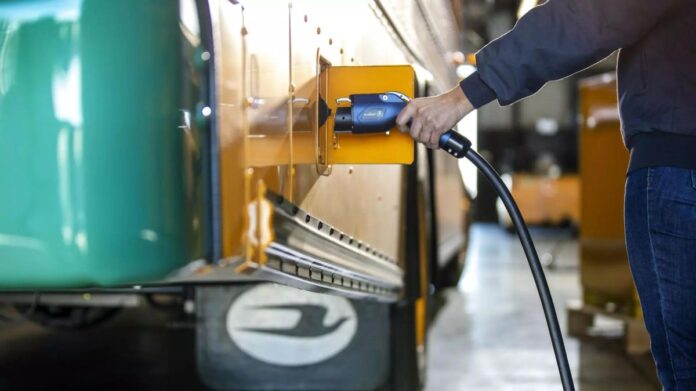Cummins’ Accelera brand may use cells produced at its new venture for electric school and transit buses and stationary storage packs.
Accelera by Cummins, Bluebird
Cummins, Daimler and Paccar, three of the trucking industry’s biggest players, are forming a multibillion-dollar joint venture to produce battery cells for commercial vehicles and other industrial applications at a U.S. plant, the biggest such project of its type in North America.
The companies plan to invest as much as $3 billion combined and each hold 30% stakes in the as-yet-unnamed venture, which will open in a little over three years. It will be scaled to churn out 21 gigawatt-hours of lithium-iron-phosphate, or LFP, battery cells annually at a factory site that hasn’t yet been determined, Cummins CEO and President Jennifer Rumsey told Forbes. Chinese battery maker EVE Energy will share its LFP cell technology with the venture and own a 10% stake.
Cummins, a diesel engine giant that’s expanding into cleantech, and the two truckmakers are sharing “this significant investment as our industry starts to transition to ensure we have cost-competitive, performance-leading cells we each can then use in battery packs we’ll be manufacturing independently,” Rumsey said. Many battery plants are in the works for electric cars, but “I’m not aware of any other battery project here in the U.S. or North America focused on commercial vehicle and industrial applications,” she said.
The project arrives on the heels of Cummins launching Accelera, its cleantech unit, to compete in a growing market for battery-electric and hydrogen-fueled trucks. It also coincides with makers of trucks and buses, just like automakers, being pushed to shift to electric power to curb planet-warming CO2 emissions. California, the biggest auto market in the U.S., recently created rules requiring all medium- and heavy-duty trucks operating there to be zero-emission by 2045, a move about a dozen other states may follow. Meanwhile, the federal government is offering new incentives for manufacturers to build domestic battery and component plants that the partners should be able to tap.
Electric eCascadia semis made by Daimler’s Freightliner unit charge at a Meijer distribution center in Lansing, Michigan.
© 2023 Bloomberg Finance LP
Rumsey says that the venture’s decision to use LFP, rather than lithium-ion cells typically used in electric vehicles, was driven by its relatively lower cost. Though it’s less energy-dense than lithium-ion and a bit heavier, LFP doesn’t use pricey nickel or cobalt and may prove to be more durable over time.
LFP battery chemistries also have another big advantage: They’re less likely to overheat and catch on fire than lithium-ion cells, which has been a problem for both car- and truckmakers. Electric truck startup Nikola had to recall all of its semis this year to fix a glitch causing battery packs to overheat.
The Cummins-Daimler-Paccar joint venture could be delayed getting off the ground because one of the partners, EVE, is a China-based company. The Committee on Foreign Investment in the United States, or CFIUS, will review the deal to ensure there are no problems with EVE’s participation, the companies said in an emailed statement.
“For this LFP chemistry, EVE really has a leading solution and the technology manufacturing know-how,” Rumsey told Forbes. “This is about creating a plant here in the U.S., building a supply chain and U.S. jobs.”
Nearly every other major new North American battery plant announced over the past year is focused on lithium-ion cells, though Ford is investing $3.5 billion for a new factory in Michigan that will make both LFP cells and nickel cobalt manganese lithium-ion batteries. That project also relies on LFP tech from a Chinese partner, Contemporary Amperex Technology Limited, or CATL, the world’s top battery maker.
Each partner will decide how to use cells in their products. Cummins’ Accelera may focus on using them in buses and medium-duty vehicles as well as stationary energy storage systems, Rumsey said. Daimler, maker of Freightliner, Mercedes-Benz and Fuso brands, and Paccar, which builds Kenworth and Peterbilt semis, will use them for trucks.
In terms of scale, the new plant’s 21-gWh output would create the materials for enough batteries to power 80,000 medium-duty trucks a year or up to 40,000 electric buses, Rumsey said.
In addition to batteries, Cummins, Daimler and Paccar are also developing hydrogen fuel cell systems and trucks. While the technology is tricky to work with, hydrogen-fueled systems are expected to offer greater driving range and faster refueling time for long-haul semis.
A Kenworth T680E electric truck charges in Long Beach, California.
© 2023 Bloomberg Finance LP



